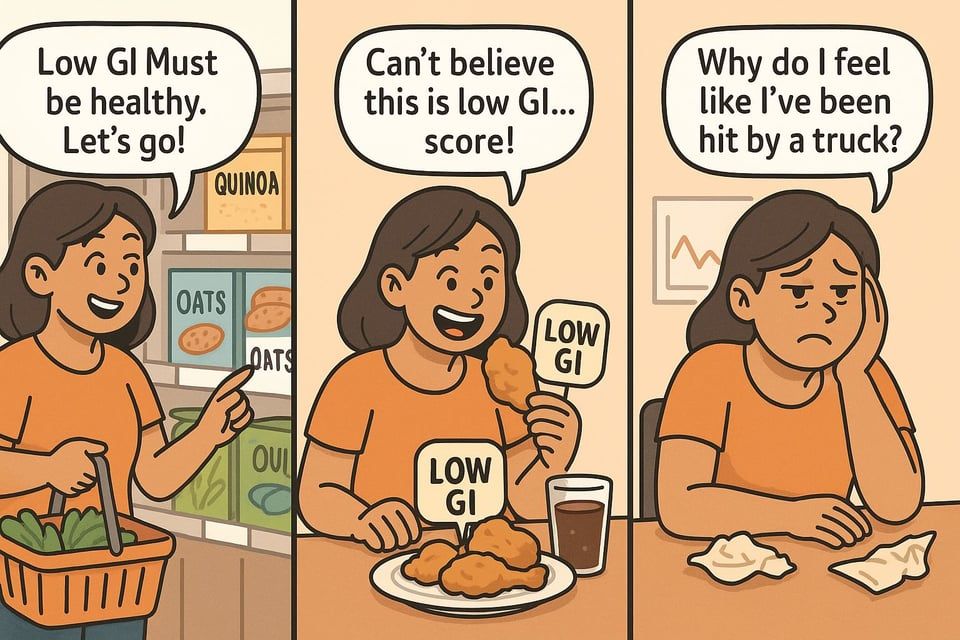What Is the Glycemic Index? A Simple Guide to Understanding Sugar Speeds
Published on 6/27/2025 · 📖 4 min read

Have you ever eaten a bowl of white rice and felt sleepy soon after, but stayed full of energy after a quinoa salad? That’s your blood sugar reacting differently to the foods you eat. And one key reason is something called the Glycemic Index—or GI for short.
Let’s break it down in the simplest way possible.
🍭 What Is the Glycemic Index (GI)?
Imagine your food has a sugar speed limit. The Glycemic Index tells you how fast that food turns into sugar in your blood.
- Low GI (55 or less): Slow sugar release = steady energy
- Medium GI (56–69): Moderate speed = a little faster, but not crazy
- High GI (70+): Fast sugar spike = energy rush, then crash
This idea was created by scientists in the 1980s to help people understand which foods might spike blood sugar quickly. Fast spikes can make you tired, grumpy, or extra hungry soon after eating.
🍽️ Meet Alex and Jamie
Let’s say it’s breakfast time.
- Alex eats a bagel and drinks orange juice. Both are high GI.
- Jamie eats eggs, avocado, and whole grain toast. This meal is low GI and balanced.
Two hours later:
- Alex feels sleepy and craves snacks.
- Jamie still feels focused and full.
Why? Because Jamie’s meal released sugar slowly. Alex’s food flooded the system quickly, causing a crash. It's not magic. It's blood sugar science.
❌ Is Low GI Always Healthy?
Here’s where it gets tricky. Not all low GI foods are good for you.
Surprise: Ice cream and chocolate milk have low GI scores! Why? Because fat slows down sugar release.
But these foods are:
- High in sugar
- High in calories
- Low in nutrients
Same with fried chicken. It may have a low GI score, but it’s high in fat, often ultra-processed, and commonly eaten with sugary drinks or fries. The GI alone doesn't tell the whole story.
✌️ The Simple Rule That Works
You want to eat foods that:
- Release sugar slowly (low GI)
- Give you long-lasting energy
- Are rich in nutrients
The magic combo is:
- Slow carbs (like sweet potatoes or lentils)
- Protein (like eggs or chicken)
- Fiber (from veggies)
- Healthy fats (like avocado or olive oil)
That’s how you avoid energy crashes and stay full longer.
🍝 What About Glycemic Load?
Now let’s add another layer: Glycemic Load (GL).
GL looks at two things:
- How fast the sugar enters your blood (GI)
- How much sugar you’re actually eating (portion size)
Example:
- Alex eats 3 bowls of whole wheat pasta. Pasta is low GI, but that’s a lot of carbs.
- Jamie eats one serving of quinoa with roasted veggies.
Even though Alex picked a "low GI" food, the giant portion means a high sugar load. That can still raise his blood sugar too much.
🧪 Why Scientists Care About Load
People noticed weird things like:
- Watermelon has a high GI but doesn’t spike blood sugar as expected.
- Pasta has a low GI but makes some people crash after a big serving.
So scientists created Glycemic Load to explain this better.
GI = speed
GL = speed + quantity
🔍 How GlucoSpike AI Helps
At GlucoSpike, we don’t just look at a food’s GI. We look at how much you eat and how it might behave in a real meal.
For example:
- A small piece of watermelon? Probably fine.
- A giant plate of pasta? Might be too much sugar at once.
Our app gives you predictions so you can eat smarter, without needing a calculator or science degree.
Learn more about how GlucoSpike AI works
📉 The Takeaway
Let’s make it super simple:
- Low GI means slow sugar—but it’s not always healthy
- Glycemic Load tells the full story—speed + quantity
- Portion size matters—even for "good" foods
- Balance is key—mix carbs with fiber, protein, and healthy fats
Your blood sugar loves slow, steady, and balanced meals. The more you understand your food, the better you can feel all day.
About the Author
This article was written by a GlucoSpike wellness writer. We break down complex topics into easy wellness tips based on trusted science. Our goal is to help you feel more confident in your everyday choices.
 GlucoSpike AI
GlucoSpike AI 

